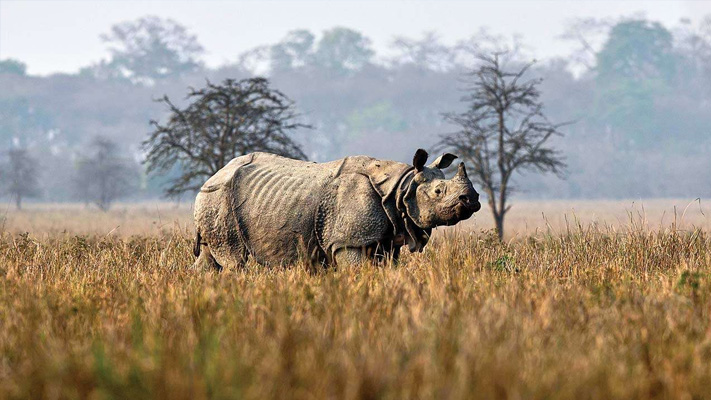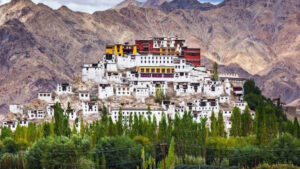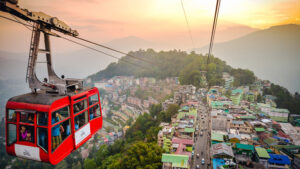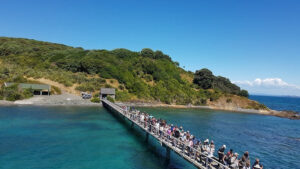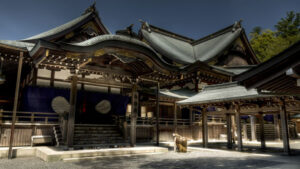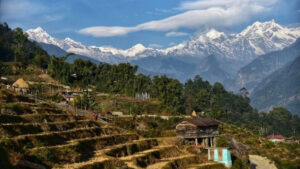KAZIRANGA NATIONAL PARK, ASSAM – WHERE RHINOS ROAM FREE AND NATURE THRIVES

Kaziranga National Park, located in the northeastern state of Assam, India, is a celebrated wildlife sanctuary and a UNESCO World Heritage Site. Established in 1905, it spans approximately 430 square kilometers and is renowned for its remarkable conservation efforts and the thriving population of the Indian one-horned rhinoceros. The park’s diverse ecosystem, encompassing tall elephant grass, marshes, and scattered forests, provides a haven for numerous endangered species, making Kaziranga a treasure trove for wildlife enthusiasts and nature lovers. With its breathtaking landscapes and remarkable biodiversity, Kaziranga National Park stands as a remarkable testament to India’s commitment to preserving its natural heritage.

The park is primarily known for its significant population of the Indian one-horned rhinoceros and the key features of Kaziranga National Park include:
1. Biodiversity: Kaziranga is home to a diverse range of flora and fauna. Apart from the one-horned rhinoceros, it shelters other notable species like tigers, elephants, wild water buffalo, swamp deer, and numerous bird species.
2. Indian One-horned Rhinoceros: The park is famous for its conservation efforts and successful population recovery of the Indian one-horned rhinoceros. It houses the largest population of these rhinos in the world.
3. Riverine Landscape: Kaziranga is located in the floodplains of the Brahmaputra River. The park’s terrain is characterized by tall elephant grass, marshes, and scattered patches of dense forests, interspersed with water bodies.
4. Jeep and Elephant Safaris: Visitors can explore the park through guided jeep and elephant safaris. These provide an opportunity to witness the wildlife up close and appreciate the natural beauty of the surroundings.
5. Birdwatching: Kaziranga is a paradise for bird enthusiasts, as it hosts a wide variety of avian species, including migratory birds that visit during the winter months. Spotting rare and endangered species like the Bengal florican and great Indian hornbill is a highlight for birdwatchers.
6. Conservation Efforts: The park has been instrumental in the conservation of various species, particularly the Indian one-horned rhinoceros. It also plays a significant role in protecting other endangered animals and preserving their habitats.
Experiences for Tourists
Kaziranga National Park offers a range of experiences for tourists, allowing them to immerse themselves in the captivating wildlife and natural beauty of the park. Here are some notable experiences that visitors can enjoy:

1. Jeep Safaris: Guided jeep safaris are a popular way to explore Kaziranga National Park. Accompanied by knowledgeable guides, visitors can venture into the park’s different zones and have the opportunity to spot various wildlife species, including the iconic Indian one-horned rhinoceros, tigers, elephants, deer, and an array of bird species. Jeep safaris provide a thrilling and up-close encounter with the park’s remarkable biodiversity.
2. Elephant Safaris: Elephant safaris offer a unique and traditional way to navigate through the tall grasslands of Kaziranga. Riding on the back of elephants, visitors can traverse areas inaccessible by vehicles and get a closer look at the wildlife. It’s a memorable experience to witness rhinos, deer, and other animals from the vantage point of an elephant.
3. Birdwatching: Kaziranga is a paradise for birdwatchers. The park is home to over 480 species of birds, including various migratory birds that arrive during winter. Birdwatching enthusiasts can indulge in spotting colorful and rare avian species such as the great Indian hornbill, swamp francolin, Bengal florican, and many others.
4. Nature Walks: Guided nature walks allow visitors to explore the park on foot and experience its enchanting beauty at a leisurely pace. Accompanied by trained naturalists, these walks provide an opportunity to learn about the park’s unique ecosystem, spot smaller wildlife species, and appreciate the rich flora and fauna up close.
5. Visiting the Bagori and Panbari Reserved Forests: Adjacent to Kaziranga National Park, the Bagori and Panbari Reserved Forests offer additional opportunities for wildlife encounters. Visitors can explore these forests on guided tours and have a chance to see different species of primates, reptiles, and smaller mammals.
6. Orchid and Biodiversity Park: Kaziranga also features an Orchid and Biodiversity Park, where visitors can admire a stunning collection of orchids and learn about the park’s rich biodiversity. The park showcases various indigenous orchid species and provides valuable insights into the region’s flora.
It is important to note that these experiences may be subject to certain regulations and seasonal variations. It is advisable to check with the park authorities or tour operators for the most up-to-date information and to ensure compliance with any rules or guidelines for visiting the park.
Main Attractions and Must See Places Nearby
Kaziranga National Park itself is a major attraction with its abundant wildlife and breathtaking landscapes. However, there are also several must-see places nearby that complement the visit to the park. Here are some of the main attractions and must-see places in the vicinity of Kaziranga National Park:

1. Majuli Island: Located on the Brahmaputra River, Majuli Island is the largest river island in the world and a cultural hub. It is known for its unique Neo-Vaishnavite culture, ancient monasteries (Satras), and traditional arts and crafts. Visiting Majuli offers a glimpse into Assam’s cultural heritage.
2. Orang National Park: Situated about 80 kilometers from Kaziranga, Orang National Park is another wildlife sanctuary worth exploring. It is home to the great Indian one-horned rhinoceros, elephants, tigers, and a variety of bird species. The park is known for its picturesque landscapes and tranquil surroundings.
3. Hoolongapar Gibbon Wildlife Sanctuary: Located approximately 50 kilometers from Kaziranga, Hoolongapar Gibbon Wildlife Sanctuary is known for its population of the endangered Hoolock Gibbons. It is one of the few remaining protected areas where these primates can be observed in their natural habitat.
4. Tezpur: Known as the cultural capital of Assam, Tezpur is a historic town located about 60 kilometers from Kaziranga. It is home to ancient ruins, temples, and archaeological sites. The scenic beauty of Tezpur, with its surrounding hills and the Brahmaputra River, adds to its charm.
5. Nameri National Park: Situated around 130 kilometers from Kaziranga, Nameri National Park is renowned for its rich biodiversity and the opportunity for wildlife encounters. The park is home to tigers, elephants, leopards, and a variety of bird species. Visitors can engage in activities like river rafting, trekking, and birdwatching in Nameri.
6. Agnigarh Hill: Located in Tezpur, Agnigarh Hill is a popular tourist spot known for its historical significance and panoramic views of the Brahmaputra River. According to Hindu mythology, it is believed to be the fortress where Princess Usha was kept captive.
These attractions and places near Kaziranga National Park offer diverse experiences, ranging from wildlife encounters and cultural immersion to historical exploration and scenic beauty. Exploring these nearby attractions can enrich your visit to Kaziranga and provide a well-rounded experience of the region.
Best Time to Visit
The best time to visit Kaziranga National Park is during the winter season, from November to April. This period offers the most favorable weather conditions and optimal wildlife viewing opportunities. Here’s a breakdown of the seasons and their characteristics:

1. Winter (November to February): This is the peak tourist season in Kaziranga. The weather is generally dry and pleasant, with temperatures ranging from 5°C to 25°C (41°F to 77°F). The vegetation is less dense during this time, making it easier to spot wildlife, including the one-horned rhinoceros and other animals. Migratory birds also arrive in large numbers during winter, enhancing the birdwatching experience.
2. Spring (March to April): Spring in Kaziranga is marked by gradually rising temperatures, with daytime temperatures ranging from 15°C to 30°C (59°F to 86°F). The park becomes greener as the vegetation starts to flourish. This period is ideal for nature walks and exploring the park’s diverse flora and fauna.
It’s important to note that Kaziranga National Park is usually closed for visitors from May to October. The park receives heavy rainfall during this time, leading to flooding and making it unsafe for tourism activities.
How to Reach
By Air: The nearest airport to Kaziranga National Park is Lokpriya Gopinath Bordoloi International Airport in Guwahati, which is approximately 217 kilometers away. From the airport, you can hire a taxi or take a private vehicle to reach Kaziranga.
By Train: The nearest railway station to Kaziranga National Park is Furkating Junction, situated approximately 75 kilometers away. Furkating Junction is well-connected to major cities in India, including Guwahati and Kolkata. From the railway station, you can hire a taxi or take a bus to reach Kaziranga, which typically takes around 2 hours.
By Road: Kaziranga National Park is connected to various cities and towns in Assam through a well-developed road network. The most common routes are:
1. Guwahati to Kaziranga: The distance between Guwahati and Kaziranga is approximately 217 kilometers. You can hire a taxi or take a bus from Guwahati to reach Kaziranga. The journey usually takes around 4 to 5 hours.

2. Jorhat to Kaziranga: Jorhat is another major city near Kaziranga, located approximately 100 kilometers away. You can hire a taxi or take a bus from Jorhat to reach Kaziranga, which takes around 2 to 3 hours.



